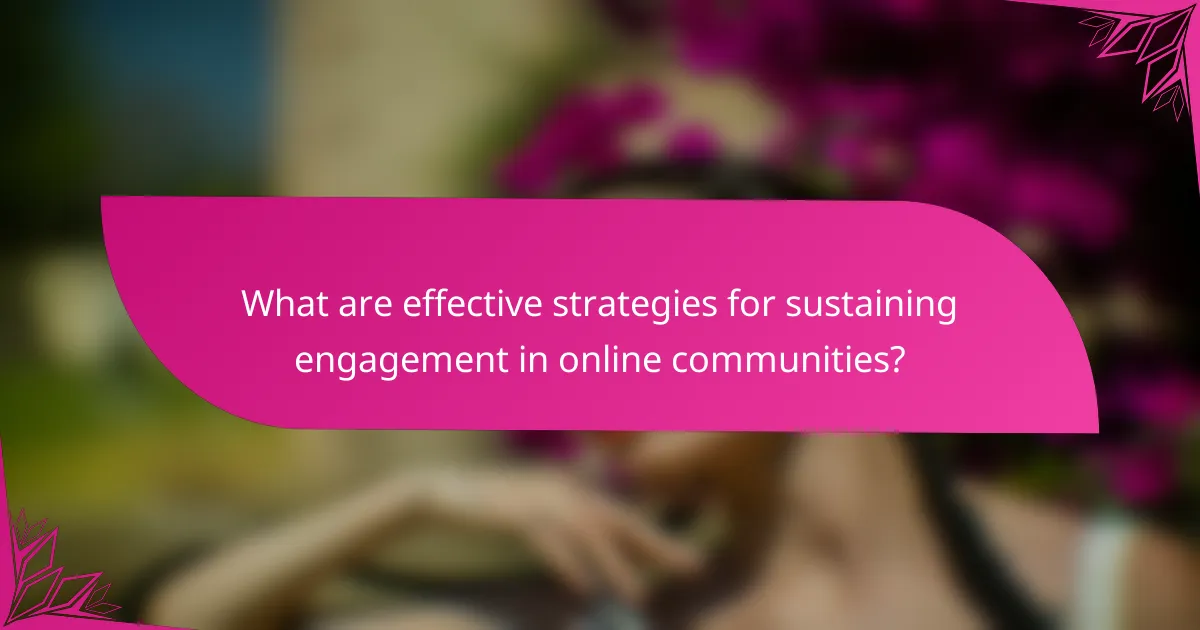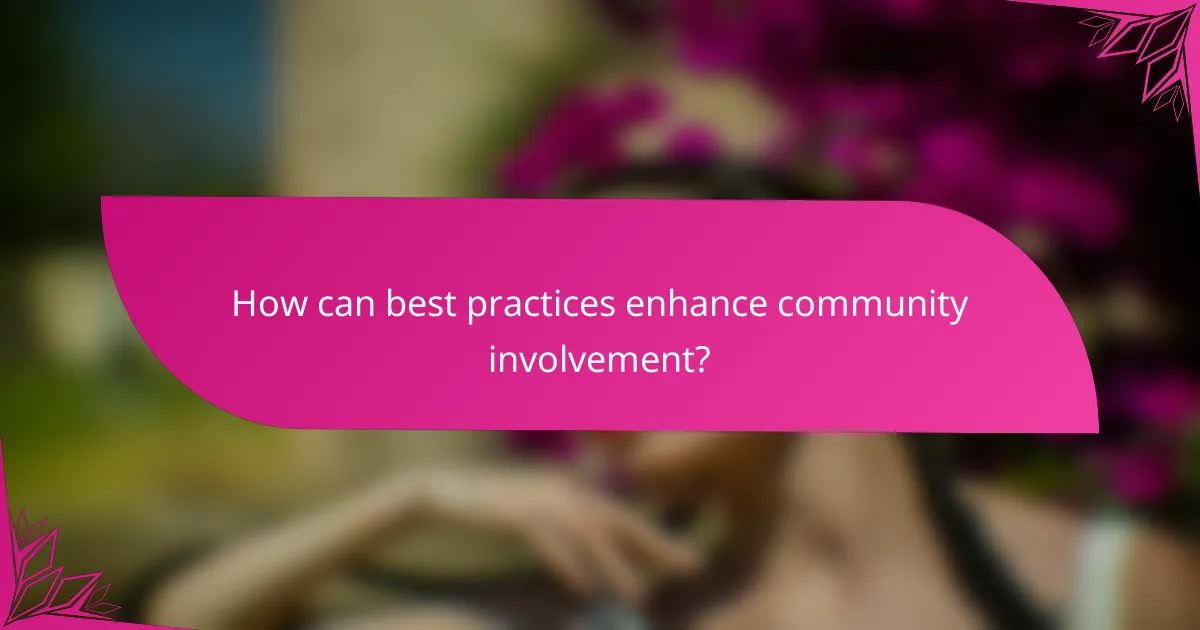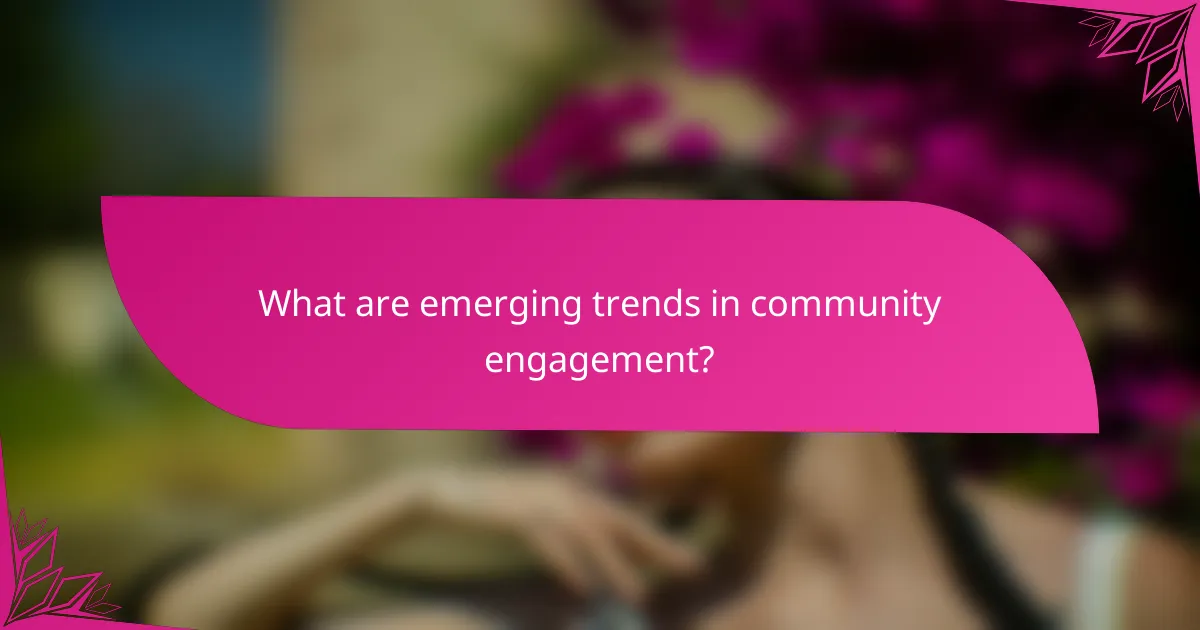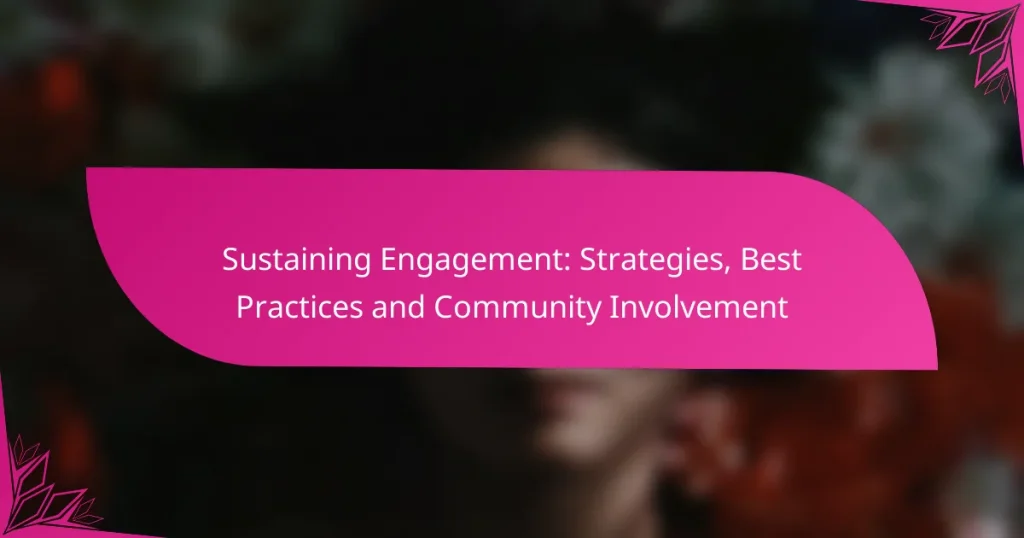Sustaining engagement in online communities requires a blend of effective strategies and best practices that foster participation and a sense of belonging. By implementing regular content updates, interactive events, and personalized communication, organizations can create a welcoming environment that encourages active involvement. Leveraging technology further enhances these efforts, enabling real-time connections and data-driven insights to tailor engagement approaches.

What are effective strategies for sustaining engagement in online communities?
Effective strategies for sustaining engagement in online communities include regular content updates, interactive events, personalized communication, gamification techniques, and feedback loops. These approaches help maintain interest and foster a sense of belonging among community members.
Regular content updates
Regular content updates are crucial for keeping community members engaged and informed. This can include blog posts, articles, videos, or social media updates that provide fresh insights or entertainment. Aim for a consistent schedule, such as weekly or bi-weekly updates, to establish expectations.
Consider using a content calendar to plan and track your updates. This ensures a diverse range of topics and formats, catering to different interests within the community. Engaging visuals and interactive elements can enhance the appeal of your content.
Interactive events and webinars
Hosting interactive events and webinars is an effective way to engage community members in real-time. These events can include Q&A sessions, panel discussions, or workshops that allow participants to interact directly with experts or each other. Aim for monthly or quarterly events to keep the momentum going.
Promote these events through various channels, such as email newsletters and social media, to maximize attendance. Offering incentives, like exclusive content or discounts, can also encourage participation and create a sense of urgency.
Personalized communication
Personalized communication helps build stronger relationships within the community. Tailor your messages based on member preferences, behaviors, or demographics to make them feel valued. This can be achieved through targeted emails, personalized recommendations, or direct messages.
Utilizing segmentation tools can enhance your ability to deliver relevant content. Avoid generic messages, as they may lead to disengagement. Instead, focus on creating a more intimate experience that resonates with individual members.
Gamification techniques
Gamification techniques can significantly boost engagement by incorporating game-like elements into community interactions. This can include leaderboards, badges, or rewards for participation, which motivate members to contribute more actively. Consider implementing a points system where users earn rewards for engaging with content or participating in discussions.
Ensure that the gamification elements align with your community’s goals and values. Overly complex systems may deter participation, so keep it simple and intuitive. Regularly update the rewards to maintain interest and encourage ongoing engagement.
Feedback loops and surveys
Establishing feedback loops and conducting surveys are essential for understanding community needs and preferences. Regularly solicit input from members about their experiences, interests, and suggestions for improvement. This can be done through short surveys or feedback forms after events or content releases.
Acting on feedback is crucial; share how member suggestions have influenced changes within the community. This demonstrates that their opinions matter, fostering a sense of ownership and loyalty among members. Aim to conduct surveys at least twice a year to keep a pulse on community sentiment.

How can best practices enhance community involvement?
Best practices can significantly boost community involvement by creating a structured and welcoming environment. They provide clear expectations and encourage participation, leading to a more engaged and active community.
Establishing clear community guidelines
Clear community guidelines set the tone for interaction and participation. They outline acceptable behavior, help prevent conflicts, and ensure that all members understand the community’s values and objectives.
When creating guidelines, consider including rules about respect, privacy, and constructive feedback. Regularly review and update these guidelines to reflect the evolving needs of the community.
Encouraging user-generated content
User-generated content (UGC) fosters a sense of ownership and belonging among community members. By encouraging users to share their experiences, ideas, and creations, you can enhance engagement and diversify the content available.
To promote UGC, consider hosting contests, challenges, or themed discussions. Recognizing contributions publicly can motivate others to participate and share their own content.
Recognizing and rewarding active members
Recognizing and rewarding active members is crucial for maintaining engagement. Acknowledgment can take many forms, from shout-outs in community newsletters to tangible rewards like discounts or exclusive access to events.
Implement a system to track contributions and participation levels. This can help identify members who consistently engage and deserve recognition, fostering a culture of appreciation and motivation within the community.

What role does technology play in engagement strategies?
Technology is essential in shaping effective engagement strategies by facilitating communication, enhancing user experience, and providing valuable insights. It allows organizations to connect with their audience in real-time and tailor their approaches based on data-driven decisions.
Utilizing social media platforms
Social media platforms are vital for fostering engagement as they enable direct interaction between brands and their audiences. By leveraging platforms like Facebook, Instagram, and Twitter, organizations can share content, respond to inquiries, and build community around their brand.
To maximize engagement, focus on creating shareable content and encourage user-generated contributions. Regularly posting updates and engaging with followers can significantly increase visibility and strengthen relationships.
Implementing community management tools
Community management tools help streamline interactions and manage relationships with users effectively. These tools can include forums, chat applications, and customer relationship management (CRM) systems that facilitate communication and provide a centralized platform for engagement.
Choose tools that offer features like automated responses, user segmentation, and analytics to track engagement levels. This can help identify active users and tailor strategies to enhance their experience, ensuring that community members feel valued and heard.
Leveraging analytics for insights
Analytics play a crucial role in understanding engagement patterns and user behavior. By analyzing data from social media, website traffic, and community interactions, organizations can gain insights into what content resonates most with their audience.
Utilize analytics tools to track key performance indicators (KPIs) such as engagement rates, click-through rates, and user demographics. This data can inform future strategies, allowing for adjustments that better meet the needs and preferences of the community.

What are the prerequisites for building a successful community?
Building a successful community requires a clear understanding of your target audience, measurable goals, and the right platform for engagement. These prerequisites lay the foundation for effective interaction and sustained participation.
Defining target audience
Identifying your target audience is crucial for community success. Consider demographics such as age, interests, and location to tailor your approach effectively. For instance, a community focused on tech enthusiasts may attract younger individuals who are more engaged online.
Utilize surveys and social media analytics to gather insights about potential members. This data helps in crafting content and discussions that resonate with their preferences and needs.
Setting measurable goals
Establishing measurable goals provides direction and benchmarks for your community’s growth. Goals can include increasing membership by a specific percentage, boosting engagement rates, or hosting a certain number of events annually.
Use the SMART criteria—Specific, Measurable, Achievable, Relevant, Time-bound—to formulate these objectives. For example, aim to increase active participation by 20% over six months through regular events and interactive content.
Choosing the right platform
Selecting the right platform is essential for facilitating community interaction. Consider where your target audience already engages, whether that’s social media, forums, or dedicated community apps. Each platform has unique features that can enhance user experience.
For example, Facebook Groups may be suitable for casual discussions, while platforms like Discord offer real-time communication for gaming communities. Evaluate the pros and cons of each option to ensure it aligns with your community goals and audience preferences.

How can subscription models enhance community engagement?
Subscription models can significantly boost community engagement by providing members with exclusive access to content and events. These models foster a sense of belonging and encourage active participation, which can lead to a more vibrant and interactive community.
Exclusive content for members
Offering exclusive content to subscribers is a powerful way to enhance engagement. This can include in-depth articles, videos, podcasts, or downloadable resources that are not available to non-members. By providing unique insights or specialized knowledge, communities can incentivize membership and keep members returning for more.
Consider creating a content calendar that outlines when new exclusive materials will be released. This helps maintain anticipation and encourages members to stay engaged over time.
Member-only events and forums
Hosting member-only events and forums creates opportunities for direct interaction among community members. These can range from virtual meetups and webinars to in-person gatherings, depending on the community’s size and location. Such events foster networking and collaboration, enhancing the overall community experience.
Utilizing platforms like Zoom or Discord for virtual events can facilitate participation from members across different regions. Ensure that events are well-promoted in advance to maximize attendance and engagement.
Tiered membership benefits
Implementing tiered membership benefits allows communities to cater to different levels of engagement and investment. For example, basic members might receive access to exclusive content, while premium members could enjoy additional perks like one-on-one consultations or priority access to events.
This structure not only encourages members to upgrade but also helps in segmenting the community based on interests and commitment levels. Clearly communicate the benefits of each tier to help members choose the option that best fits their needs.

What are emerging trends in community engagement?
Emerging trends in community engagement focus on leveraging technology and fostering inclusivity to enhance participation. These trends emphasize the importance of digital platforms, collaborative decision-making, and creating spaces for diverse voices.
Leveraging Technology for Engagement
Technology plays a crucial role in modern community engagement by facilitating communication and participation. Social media platforms, mobile apps, and online forums allow communities to connect and share information quickly. For example, local governments often use apps to gather feedback on community projects, enabling real-time interaction.
When implementing technology, consider accessibility to ensure all community members can participate. This may involve providing multilingual options or ensuring compatibility with various devices. Regularly updating platforms and engaging users through interactive content can also maintain interest and involvement.
Fostering Inclusivity and Diversity
Inclusivity is essential for effective community engagement, as it ensures that all voices are heard. Strategies to promote diversity include outreach programs targeting underrepresented groups and creating safe spaces for dialogue. For instance, hosting community forums in various neighborhoods can help gather input from a broader demographic.
To foster inclusivity, organizations should actively seek feedback on their engagement methods. This can involve surveys or focus groups to understand barriers faced by different community members. Adjusting strategies based on this feedback can lead to more effective and representative engagement.
Collaborative Decision-Making
Collaborative decision-making involves engaging community members in the planning and implementation of initiatives. This approach not only builds trust but also empowers residents to take ownership of local issues. Techniques such as participatory budgeting allow community members to directly influence how funds are allocated.
To implement collaborative decision-making, establish clear processes and guidelines that encourage participation. Providing training or resources can help community members understand how to engage effectively. Regularly communicating outcomes and progress can also reinforce the value of their contributions.


